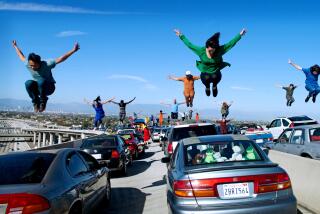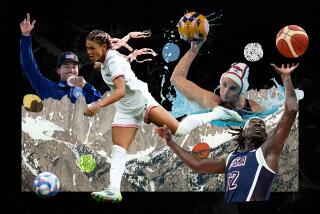Apparel makers drape Americans in red, white and blue style
When U.S. athletes take the track for the opening ceremonies at the Winter Olympics on Friday in Vancouver, they will be dressed like Ivy League boaters returning from an afternoon sailing off the Cape -- in the 1930s.
The spiffy uniforms, designed by Polo Ralph Lauren, include slender cream pants, a navy newsboy cap and a red-and-navy shawl-collared sweater embroidered with the iconic polo insignia on one shoulder. They feel so campy-American they might as well include a squash racket and a mint julep.
The head-to-toe look was inspired by “historic Olympic Games, specifically Lake Placid 1932,” said David Lauren, senior vice president of advertising, marketing and corporate communications for Ralph Lauren.
The preppy ensembles, which will be worn for the Games’ opening and closing ceremonies, are among a laundry list of bold looks poised to unfurl at the 2010 Winter Games.
For sportswear and athletics companies, the Olympics are the Oscars of promotional events. Dressing athletes on or off the ice is a chance to be seen by a global audience and to align with one of the most beloved (and wholesome) events in existence. So companies bid to pay top dollar to have their logo splashed across the well-toned chests of international athletes.
Apparel company representatives we talked with demurred when asked how much they are paying for the privilege of dressing a team, but it is generally understood among brands that sponsoring one of the more popular sports -- such as snowboarding or short-track skating -- is more costly than a less-watched event.”Like any college football team, when the opportunity for sponsoring an Olympic team comes out, the phone calls happen -- I think there’s always a bidding process,” said Nick Cienski, director of outdoor design and innovation for athletic wear company Under Armour, which designed the competition uniforms for the U.S. bobsled, skier-cross and mogul teams for Vancouver.
For a young company such as Under Armour, sponsorship is a chance to home in on its consumer base.
“Freestyle [skiing] is arguably where the younger, more adventurous kids are,” Cienski said. “It’s a good opportunity for us.”
The Yanks are coming
When designing the high-tech body suits and pants-jackets ensembles, the Baltimore-based company (which is dressing Olympic athletes for the first time) took design cues from 1970s action-hero icons, including Evel Knievel and Captain America. The Lycra-heavy bobsled uniforms even look like a superhero suit: They’re Superman-blue, skintight and feature a graphically wild stars-and-stripes design scheme.
“We went really far and deep when looking at iconic America,” Cienski said. “We wanted something where you’d know instantly that someone is from America.”
But when it comes to creative dress, no other winter sport rivals figure skating -- and for obvious reasons: It’s the only Olympic event that encourages athletes to don sequined unitards, ostrich feathers and flamenco-dancer ruffles.
There’s no telling what the top U.S. skaters will be wearing in Vancouver, but after getting death threats for wearing real fox fur on his costume at the U.S. Figure Skating Championships on Jan. 17, skater Johnny Weir will reportedly be switching to faux pelts. And world champion Evan Lysacek has paired with fashion designer Vera Wang in an attempt to tone down some of the Vegas razzle-dazzle endemic to the sport.
But we’re sure to see some telltale sequins on the celebrity performers booked for the opening and closing ceremonies. Dean and Dan Caten, the twin brother designers behind Dsquared2, are the official “talent costume designers” for both events.
Our true colors
Athletic juggernaut Nike has created what’s sure to be the most-photographed U.S. uniform of the Winter Games -- the medal stand outfit.
All gold, silver and bronze winners from the United States will wear a comfy head-to-toe Nike look when collecting their hardware: a down “puffer” jacket in a navy, ombre-dyed nylon, emblazoned with a Nike swoop and the Vancouver Olympics logo on the front and a huge crimson “USA” on the back; waterproof pants; a sporty top; ‘70s-inspired Nike “Blazer” sneakers; and an optional knit cap.
Snowboarding company Burton, which returns as outfitter for the U.S. snowboarding team for the second consecutive Winter Olympics, will fly the American flag in a more subtle way.
In Vancouver, athletes will rip up the half-pipe in a red, white and blue plaid snow jacket and Gore-Tex snow pants made to simulate the look of worn-in jeans -- with nicks, scuffs and even faux holes.
“What could be more American than jeans?” said Greg Dacyshyn, senior vice president of creative for Burton, who added, “Snowboarding is such an individual sport and so much about individual expression, so to have uniforms for it is a little counterintuitive. Red, white and blue -- we wanted to do it in a new and unexpected way. I think it will definitely raise a few eyebrows.”
Another head-turning competition outfit will be worn by the U.S. luge team. Athletes will fly down the ice in skintight body suits created by athletic wear company Karbon, featuring a graphic of red-and-yellow flames running up each leg. With the fastest luge speed recorded at 86.6 mph -- courtesy of Tony Benshoof in 2001 -- the NASCAR-like graphic seems wholly appropriate.






